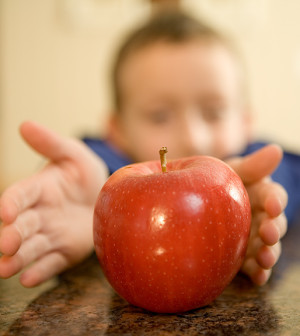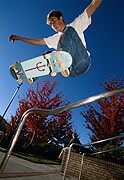- Navigating Your Midlife Crisis: Embracing New Possibilities
- City Raccoons Showing Signs of Domestication
- Mapping the Exposome: Science Broadens Focus to Environmental Disease Triggers
- One Week Less on Social Media Linked to Better Mental Health
- Your Brain Changes in Stages as You Age, Study Finds
- Some Suicide Victims Show No Typical Warning Signs, Study Finds
- ByHeart Formula Faces Lawsuits After Babies Sickened With Botulism
- Switch to Vegan Diet Could Cut Your Greenhouse Gas Emissions in Half
- Regular Bedtime Does Wonders for Blood Pressure
- Dining Alone Could Mean Worse Nutrition for Seniors
Keep Safety in Mind When Skateboarding


Skateboarding has become increasingly popular in recent years, but it’s not without risk for serious injury.
In 2011, more than 78,000 trips to emergency rooms in the United States involved kids and teens injured in skateboarding accidents, according to the American Academy of Orthopaedic Surgeons. Most of these injuries involved boys younger than 15.
Injuries most often associated with skateboarding include cuts and bruises; sprains and strains, especially of the legs; concussions and other head injuries; and broken bones, particularly of the wrist, nose or jawbone.
Children younger than 5 should not be allowed to skateboard, according to the American Academy of Pediatrics. And kids aged 6 to 10 should be under an adult’s supervision when they ride a skateboard.
Young children have a higher center of gravity and less coordination and balance, which makes skateboarding riskier for them, the orthopedic association explained in a news release. Youngsters are also slower to react and more likely to fall and suffer a head injury.
Wearing the appropriate protective gear is important, the orthopedists also point out. This gear should include a properly fitting helmet, wrist guards, knee pads, proper shoes and goggles to protect the eyes from debris.
Choose a quality bicycle or multisport helmet that meets or exceeds safety standards of the U.S. Consumer Product Safety Commission, and replace helmets every five years or once they’ve been damaged, the association says.
Make sure children and teens use a skateboard appropriate for their level of ability and the type of riding they do. Also, inspect skateboards routinely for wheel problems, cracks, nicks or broken edges.
Young people who want to skateboard should learn the basic rules of the sport, particularly how to stop, slow down and turn.
Learning how to fall safely is also important, the orthopedic association says. Riders who lose their balance should crouch down so they don’t fall as far. When falling, relax and roll onto the fleshy parts of the body.
More information
The U.S. Consumer Product Safety Commission provides more skateboarding safety tips.
Source: HealthDay
Copyright © 2025 HealthDay. All rights reserved.










